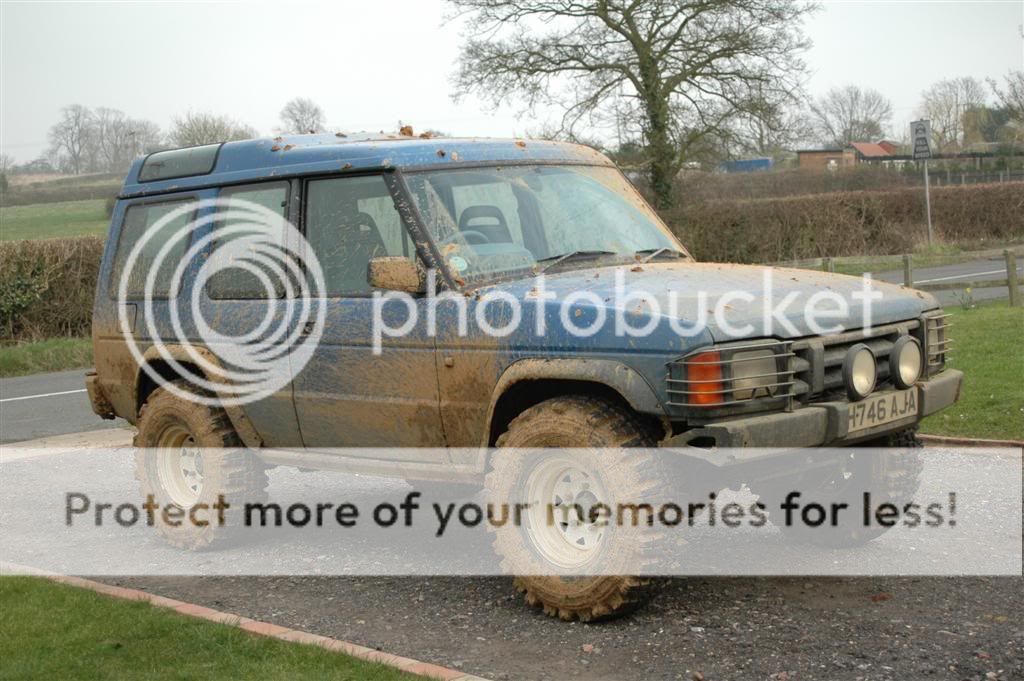Discokids
Well-Known Member
- Posts
- 3,160
- Location
- Derbyshire
There are several things to consider.
1. Why would you want to lift a vehicle? What is the purpose?
2. What is the cost of lifting a vehicle? And I don't mean in a monetary sense.
First it's probably worth examining the limitations of a D2.
1. It has large overhangs front and rear. Which limited approach and departure angles.
2. The LWB gives it a less than ideal breakover angle
3. The big bumpers, especially the front are vulnerable off road
And the good bits.
1. The total suspension travel is about equal to a standard Defender
2. The car is actually quite capable in stock trim
3. The ground clearance is generally acceptable for most forms of modest off roading
4. The vehicle is well geared for standard size tyres.
To sum up, it's really the body that restricts the D2's performance off road vs a Defender. And a standard Defender is more than capable of tackling any Green Lane in the UK.
Arguably for just green laning there is probably no need to lift a D2 at all. Just fit suitable off road tyres that fit under the arches. And note that you won't quite have the ground clearance of a Defender (easier to get beached in deep ruts) and that the body will restrict all of the approach and departure angles.
The easiest lift to address all of the negatives and not affect the positives is to fit taller tyres. This will improve approach, departure and breakover angles. And improve ground clearance, not only under the chassis, but under the diffs as well.
To solve the vulnerable bumpers, you could look at some HD aftermarket items, which will improve the approach and departure angles even more so.
Of course, there is a limit to how tall a tyre you can fit. Which is usually why people lift a vehicle. But there are other options.
So what's wrong with lifting?
Well nothing. But the approach taken can cause issues. So lets look at some of them.
1. A common way to lift a vehicle is to simply add some HD springs. And sure enough, when sitting, it will now have increased ride height, i.e. the wheel arches will be higher and a bigger gap to the wheels.
2. The most obvious issue here is. Ride quality. Generally HD springs will make for a less compliant ride on the road and of course off road as well.
3. Handling. Raising the vehicles roll centre and it's centre of gravity can cause un-wanted or excessive lean out on the open road.
4. Lifting a vehicle will change the caster angle of the hubs. Which will affect how a vehicle steers.
5. Lifting will also change the pinion angle of the diffs, which can cause vibration and binding issues.
These are all the obvious issues. Some more minor than others, some livable and some solvable by other parts.
But there are some less obvious issues too:
1. If you think about it, your suspension can only move up and down the distance of the shock absorber. This is the ultimate limiting factor. You wheel cannot move further up than when the shock is fully compressed, nor can a wheel drop any further than when the shock is fully extended.
Of course, lots of things can mean you don't get to see or use all of this travel, but the shock is really what dictates what is potentially available.
Lets assume this total range represents a value of 10.
0 = fully compressed
10=fully extended
When sitting on level ground, assume that the shock is position 5, half way extended, half way compressed.
This means you have equal travel up and down.
When you lift by using HD springs, your resting position may now be 7. You still have the same total travel, but you are now starting in a different position. And you now only have 3 units of extension left, rather than 5. Which means you'll get cross axled far easier and be far more likely to lift a wheel off road.
It's also worth bearing in mind, that a HD spring won't be as easy to compress either, so you may loose some of your available articulation.
2. Lift packers/blocks will result in something similar. Although will generally preserve the ride quality better than HD springs.
So getting back to why do you want to lift it. Oh yes, to fit taller tyres on. Because if you lift a vehicle, it'll increase the wheel arch gap and allow taller tyres on.... nope, not really.
If we think what happens under suspension compression, the wheel will move upwards. So completely negating the lift. And if you can attain full compression still, then it will be equal to having no lift at all. Which means a larger tyre is just as likely to foul when used off road.
A solution sometimes used is to fit extended bump stops. However all these really do is prevent you getting full suspension compression. It might help stopping your wheels rubbing, but will further reduce the amount of suspension articulation you have and ultimately reduce your off road capability.
Now this isn't the end of the story. There are many options open to you form this point.
1. The easiest, but arguably most brutal is to cut the wheel arches and body work. This may negate the entire need or want to lift the vehicle at all. As it will allow you to fit taller tyres on, avoid them rubbing, but still retain the full use of the suspension, without any of the negatives of lifting a vehicle.
2. More common in the Jeep world is what is known as a body lift. This essentially involves spacing the body tub up from the chassis. And will achieve a similar result to cutting the wheel arches, as the body will be further from the wheels. But this kind of lift can be difficult to fit and sometimes won't look right. And you'll get those that say it doesn't actually lift the chassis, which is correct. But it means the handling, ride and steering will also not be affected. Your "lift" will come from the bigger tyres. E.g. going from a 29" to a 33" tyre will give you a 4" lift.
3. A more comprehensive suspension setup. While there is little wrong with the standard suspension and it is more than adequate for most peoples off road needs, you can enhance and improve certain aspects of it, although it may be at the detriment to other aspects.
For more of an off road setup, what you'll want is increased articulation. This will normally involve longer shocks, maybe even new shock mounts in different positions and different springs. It might however still require you to cut the bod work to make it all fit.
The end result here is to fit tyres of suitable size on, and increase travel. And attain a suitable ground clearance for your intended needs. Keeping the centre of gravity as low as possible while meeting the other points is generally good, it will improve stability and reduce roll.
The D2's only additional complication is some have air suspension at the rear. This is neither good nor bad, but will need addressing differently to coil springs.
And ACE may have some impact on extreme setups.
The Watts linkage rear also responds differently to A frame or 4 link setups. But this is only of concern if you are massively trying to promote more travel than the standard setup is capable of.
Sorry for a long reply. But there really isn't a simple answer to all of this. If all you want to do is get a monster truck look with big tyres. Then a simple lift is fine. Just expect it to drive and behave worse on and off road. If you want to make it better off road, you'll have to work a bit harder on what you do and this may or may not involve a suspension lift.
Tyre choice is always a tough one. For most off roading in the UK, narrow tyres tend to work better than wide ones. And are usually easy to fit in the arches with less rubbing.
You might want too look at some 215/80R16 or 215/85R16's as an alternative. Although tread choice might be limited.
Some 7.00 x 16's might fit or if you are real luck you might manage to get some narrow 7.50 x 16's on there. This is the size used for the Camel Trophy D1's, but I'm afraid I don't know what sizes will fit a D2.
You may need to look at some narrower steel rims though if you go for narrow tyres.
If you don't mind cutting the arches and fitting an aftermarket arch kit, then I'd recommend 7.50 x 16, 235/86R16 or 255/85R16 as sensible sizes too look at.
Just to show this kind of thing is possible. Albeit not a D2. This was my Disco 1, it's on completely standard suspension, but has heavily trimmed arches. It's running 33.11.50R15's tyres, that measure almost 34" tall.
And it was used off road extensively, on terrain more aggressive than a green lane.
And latter mods to improve the front approach angle. Still on stock suspension:
I'm not against lifting a vehicle. But I'd only lift it if I understood why I was doing it, and what ramifications it may produce.
However I believe if you don't mind taking a cutting disc to the vehicle, then you can actually fit large tyres without the need to lift it.
For the record, I knew other people with Disco 1's at the time and despite them running 2" or more lift kits, my stock suspension Disco on Simex's would sit about 2" higher total height than any of theirs and have more room under the diffs. But still rode and drove on the road fine (excluding the fact the tyres where big ass MT's and not really a road tyre).
Hats off to you for typing all that.
Much better than the usual 'do a search FFS!'



